Health Catalyst Bundle
How Does Health Catalyst Stack Up in the Healthcare Analytics Arena?
The healthcare sector is undergoing a data revolution, and Health Catalyst SWOT Analysis is at the forefront, providing the tools and insights needed to navigate this complex landscape. Founded in 2008, the company has rapidly evolved into a major player, offering solutions that empower healthcare organizations to transform data into actionable strategies. This analysis dives deep into the competitive dynamics shaping Health Catalyst's future.
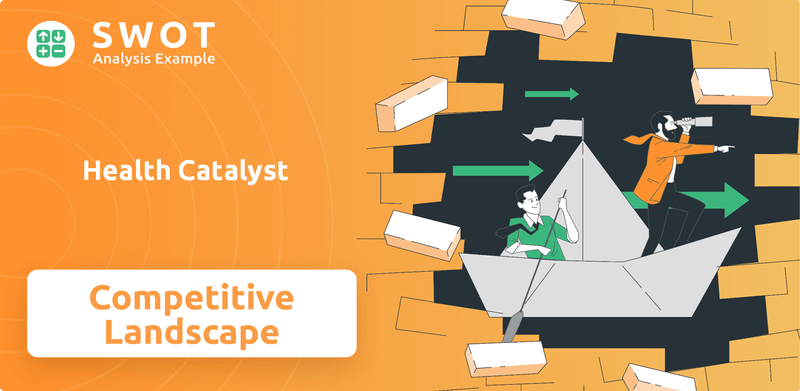
Understanding the Health Catalyst competitive landscape is crucial for anyone involved in healthcare investment or strategy. This report provides a comprehensive Health Catalyst market analysis, examining the company's position relative to its Health Catalyst competitors, and exploring the key factors driving its growth. We'll dissect the Health Catalyst key strengths and weaknesses, assess its Health Catalyst industry position, and identify the Health Catalyst challenges and opportunities that will shape its future in the world of healthcare analytics companies and data analytics in healthcare.
Where Does Health Catalyst’ Stand in the Current Market?
Health Catalyst occupies a prominent position within the healthcare data and analytics market. This sector is experiencing increasing demand for insights derived from complex healthcare data. The company is recognized as a leader in providing a comprehensive data operating system (DOS) and analytics applications tailored for healthcare organizations.
The company's core operations revolve around its DOS platform, which integrates data from various sources. It also offers a suite of analytics applications designed to improve clinical outcomes, financial performance, and operational efficiency. Health Catalyst's value proposition centers on delivering measurable improvements in patient care and financial health for its clients.
Health Catalyst primarily serves healthcare providers, including hospitals, health systems, and accountable care organizations (ACOs), across North America. The company has demonstrated consistent revenue growth, with its total revenue reaching approximately $294.6 million in 2023, reflecting a 12% increase year-over-year. This financial performance underscores its solid standing in the market. Over time, Health Catalyst has strategically expanded its offerings beyond core data warehousing to include more advanced analytics, AI-powered solutions, and professional services, indicating a shift towards a more comprehensive value proposition. The company's focus remains on delivering measurable improvements in patient care and financial health for its clients, distinguishing itself through a deep understanding of healthcare workflows and regulatory environments.
Health Catalyst is a recognized leader in the healthcare data and analytics market. Its comprehensive data operating system (DOS) and analytics applications are tailored for healthcare organizations. The company's strong market position is supported by consistent revenue growth and strategic expansion of its offerings.
In 2023, Health Catalyst's total revenue reached approximately $294.6 million. This represents a 12% year-over-year increase, demonstrating its solid financial performance. The company's revenue model relies on a combination of software subscriptions, professional services, and data analytics solutions.
Health Catalyst primarily serves healthcare providers in North America. This includes hospitals, health systems, and ACOs. The company's focus on delivering measurable improvements in patient care and financial health attracts and retains a strong customer base.
The company offers a comprehensive data operating system (DOS) and a suite of analytics applications. These solutions are designed to improve clinical outcomes, financial performance, and operational efficiency. Health Catalyst also provides professional services to support its clients.
Health Catalyst's competitive advantages include its specialized expertise and integrated platform approach. The company's deep understanding of healthcare workflows and regulatory environments sets it apart. To understand more about its growth strategy, read the article about Growth Strategy of Health Catalyst.
- Comprehensive Data Operating System (DOS)
- Analytics Applications for Healthcare
- Focus on Measurable Improvements
- Strong Customer Relationships
Health Catalyst SWOT Analysis
- Complete SWOT Breakdown
- Fully Customizable
- Editable in Excel & Word
- Professional Formatting
- Investor-Ready Format
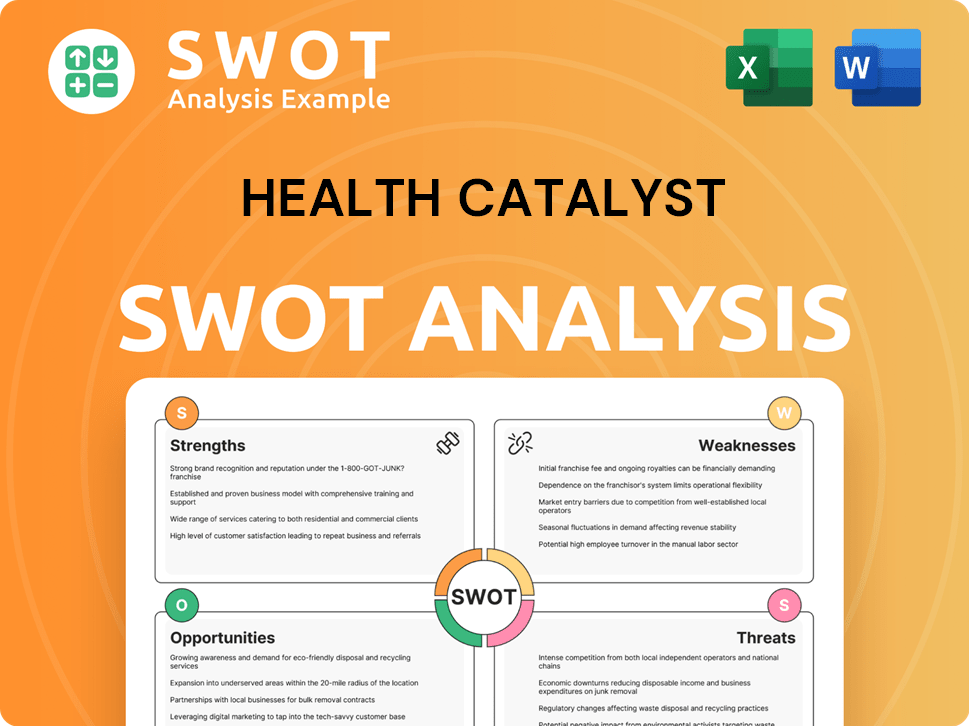
Who Are the Main Competitors Challenging Health Catalyst?
The Health Catalyst competitive landscape is characterized by a diverse set of rivals, from specialized healthcare analytics firms to large technology companies with healthcare divisions. Understanding these competitors is crucial for assessing the company's market position and growth prospects. The market analysis reveals a dynamic environment where innovation, integration capabilities, and the ability to demonstrate ROI are key differentiators.
Health Catalyst competitors are constantly evolving, with new entrants and strategic moves by established players reshaping the competitive dynamics. This section provides an overview of the key competitors, their offerings, and their impact on Health Catalyst's market share. The competitive landscape analysis helps stakeholders understand the challenges and opportunities facing the company.
The healthcare technology market is experiencing significant growth, driven by the increasing need for data-driven insights and improved operational efficiency. As a result, competition is intensifying, making it essential for Health Catalyst to maintain a strong competitive position. A thorough understanding of the Health Catalyst market analysis and its competitive environment is vital for strategic decision-making.
Direct competitors offer similar healthcare analytics and data management solutions. These companies often target the same healthcare providers and compete on features, pricing, and integration capabilities.
Arcadia specializes in value-based care analytics and population health management. They compete directly with Health Catalyst, particularly for contracts with large health systems. Recent market data shows a strong focus on expanding their offerings to include more advanced analytics.
Innovaccer provides a data activation platform and various applications aimed at improving patient engagement and operational efficiency. Innovaccer has secured substantial funding, allowing it to broaden its market reach and compete more aggressively. The company's growth strategy includes expanding its data analytics capabilities.
Oracle Cerner, primarily known for EHR systems, is increasingly developing and integrating its own analytics capabilities. This poses a competitive threat by offering bundled solutions. Oracle Cerner’s market share in the EHR space gives it a significant advantage in cross-selling analytics tools.
Epic Systems, another major EHR provider, also develops and integrates its own analytics solutions. Epic's strong presence in the healthcare market makes it a formidable competitor. Their bundled approach can be a significant advantage.
Established enterprise software vendors like IBM (with its Watson Health initiatives) and Microsoft (through its Azure healthcare solutions and strategic partnerships) are expanding their presence in healthcare data analytics. These companies leverage their extensive cloud infrastructure and AI capabilities.
The competitive landscape involves battles over integration capabilities with existing EHRs, the depth and breadth of analytics offerings, and the ability to demonstrate tangible return on investment for healthcare organizations. Key factors influencing the competitive dynamics include:
- Integration with EHRs: The ability to seamlessly integrate with existing EHR systems is crucial.
- Analytics Capabilities: The depth and breadth of analytics offerings, including predictive analytics and AI-driven insights, are critical.
- Return on Investment (ROI): Demonstrating tangible ROI for healthcare organizations is essential for winning and retaining clients.
- Market Share: Understanding the Health Catalyst market share 2024 and how it compares to competitors is vital.
- Recent Acquisitions: Analyzing Health Catalyst recent acquisitions and those of its competitors provides insight into strategic moves.
- Customer Base Analysis: Examining the Health Catalyst customer base analysis and its competitors' customer bases reveals market positioning.
Health Catalyst PESTLE Analysis
- Covers All 6 PESTLE Categories
- No Research Needed – Save Hours of Work
- Built by Experts, Trusted by Consultants
- Instant Download, Ready to Use
- 100% Editable, Fully Customizable
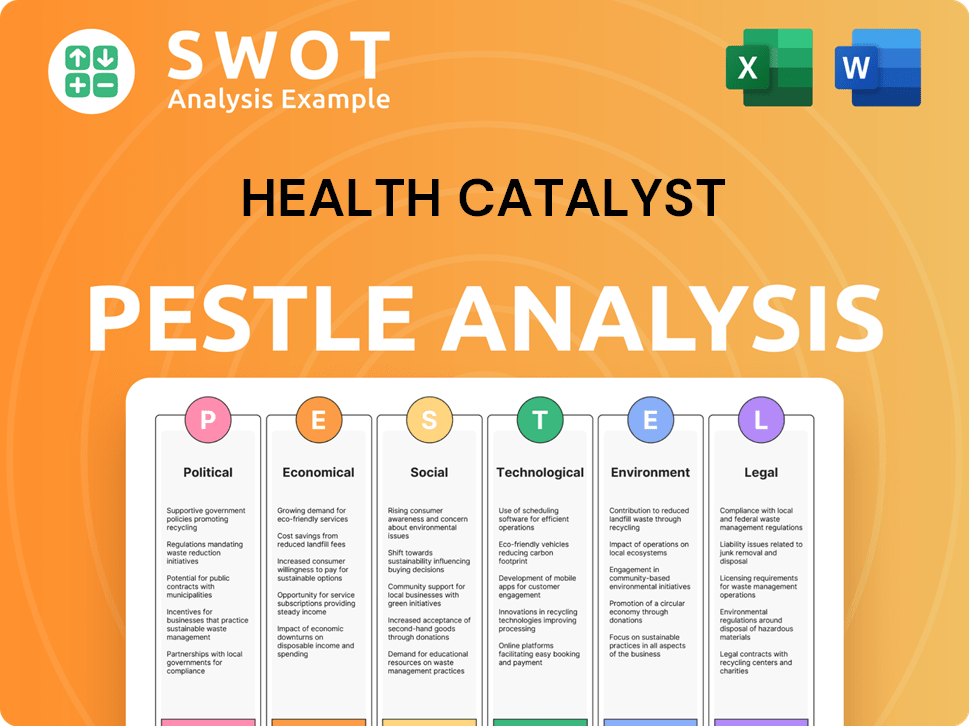
What Gives Health Catalyst a Competitive Edge Over Its Rivals?
Analyzing the Health Catalyst competitive landscape reveals several key advantages that position the company within the healthcare technology sector. These advantages are primarily rooted in its specialized focus on healthcare, proprietary technology, and a deep understanding of industry-specific challenges. A core differentiator is its Data Operating System (DOS), a unified data architecture designed specifically for the complexities of healthcare data.
This platform enables seamless integration of disparate data sources, allowing healthcare organizations to aggregate, organize, and analyze clinical, financial, and operational data more effectively than generic data solutions. The DOS is supported by a robust suite of analytics applications tailored to address critical healthcare use cases, from population health management to clinical quality improvement and cost reduction. Understanding the Health Catalyst market analysis is crucial for grasping its competitive edge.
Furthermore, Health Catalyst leverages a significant intellectual property portfolio, including patents related to its data integration and analytics methodologies. The company's strong brand equity within the healthcare provider community, built on a track record of delivering measurable outcomes, fosters customer loyalty. Its professional services arm, comprising healthcare data scientists, clinical experts, and consultants, provides crucial support in implementation and ongoing optimization, further strengthening client relationships. For a deeper dive into its target audience, consider reading about the Target Market of Health Catalyst.
The DOS provides a unified data architecture designed specifically for healthcare, enabling seamless integration of disparate data sources. This allows for more effective aggregation, organization, and analysis of clinical, financial, and operational data. It's a key differentiator in the Health Catalyst competitive landscape.
A significant intellectual property portfolio, including patents related to data integration and analytics methodologies, provides a competitive advantage. This protects its unique approaches and innovations in the healthcare analytics companies space. This is a key factor in Health Catalyst key strengths and weaknesses.
A strong brand within the healthcare provider community, built on a track record of delivering measurable outcomes, fosters customer loyalty. This reputation helps in securing new business and retaining existing clients. This is a key factor in the Health Catalyst market share 2024.
A professional services arm, comprising healthcare data scientists, clinical experts, and consultants, provides crucial support in implementation and ongoing optimization. This enhances client relationships and ensures effective use of the platform. This is a key factor in Health Catalyst competitor analysis report.
Health Catalyst's ability to demonstrate tangible improvements in patient outcomes and financial performance for its clients reinforces its value proposition. This is often achieved through case studies and published results, showcasing the effectiveness of its solutions. This is a key factor in Health Catalyst competitive advantages.
- Specialized focus on healthcare, providing tailored solutions.
- Proprietary technology, including the Data Operating System (DOS).
- Strong brand equity and customer loyalty within the healthcare provider community.
- Professional services for implementation and ongoing optimization.
Health Catalyst Business Model Canvas
- Complete 9-Block Business Model Canvas
- Effortlessly Communicate Your Business Strategy
- Investor-Ready BMC Format
- 100% Editable and Customizable
- Clear and Structured Layout
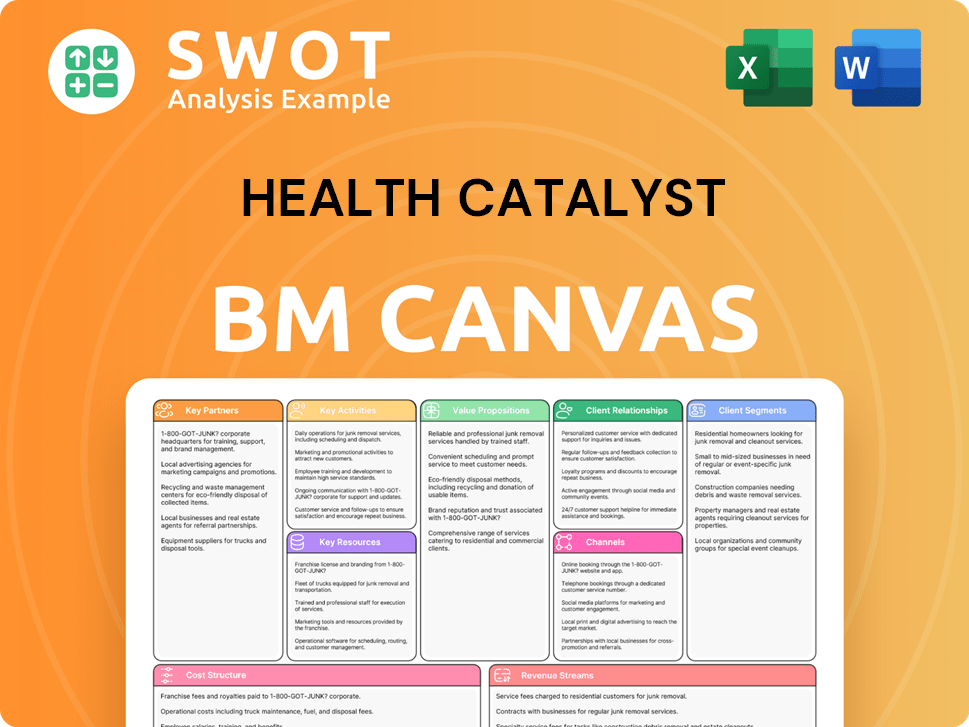
What Industry Trends Are Reshaping Health Catalyst’s Competitive Landscape?
The Health Catalyst competitive landscape is significantly influenced by industry trends, future challenges, and opportunities. The healthcare data and analytics sector is experiencing rapid growth, driven by the increasing need for data-driven insights to improve patient outcomes and reduce costs. This dynamic environment requires continuous adaptation and strategic foresight to maintain a strong market position. Understanding these factors is crucial for assessing the company's potential for sustained success.
The market analysis reveals a complex interplay of technological advancements, regulatory changes, and evolving healthcare delivery models. Companies in this space must navigate challenges such as data privacy regulations and interoperability standards while capitalizing on opportunities presented by AI and value-based care. The ability to innovate and form strategic partnerships will be key to thriving in this competitive environment.
The adoption of AI and machine learning (ML) for predictive analytics is accelerating, offering opportunities for Health Catalyst to enhance its solutions. The shift towards value-based care models necessitates robust data analytics for measuring outcomes and managing population health. Regulatory changes, particularly regarding data privacy and interoperability, require continuous adaptation.
Staying ahead of generalized AI platforms from tech giants that might enter the healthcare analytics space poses a significant challenge. The increasing consolidation among healthcare providers could lead to greater bargaining power. Maintaining data security and compliance with evolving regulations is critical.
Expanding into new geographic markets, particularly internationally, presents growth opportunities. Developing specialized solutions for niche healthcare segments and new care delivery models, such as telehealth, is promising. Strategic partnerships and demonstrating a clear return on investment for clients are crucial for success.
The company's ability to innovate rapidly and form strategic partnerships with other healthcare technology providers is a key advantage. Demonstrating a clear return on investment for its clients in an increasingly data-driven and outcomes-focused healthcare environment is essential. The company's focus on data-driven insights and outcomes-focused solutions is a key differentiator.
The Health Catalyst competitive landscape is characterized by dynamic shifts and requires a proactive approach to navigate challenges and seize opportunities. The company's ability to adapt to these changes will determine its long-term success. For a deeper understanding of the business model, consider exploring the Revenue Streams & Business Model of Health Catalyst.
The healthcare analytics market is projected to reach significant values in the coming years. The ability to leverage AI and ML for predictive analytics is a key differentiator. Regulatory compliance and data security are critical for maintaining client trust and market position.
- Focus on AI/ML integration to enhance predictive capabilities.
- Prioritize partnerships to expand market reach and solution offerings.
- Ensure robust data security and compliance measures.
- Monitor and adapt to evolving value-based care models.
Health Catalyst Porter's Five Forces Analysis
- Covers All 5 Competitive Forces in Detail
- Structured for Consultants, Students, and Founders
- 100% Editable in Microsoft Word & Excel
- Instant Digital Download – Use Immediately
- Compatible with Mac & PC – Fully Unlocked
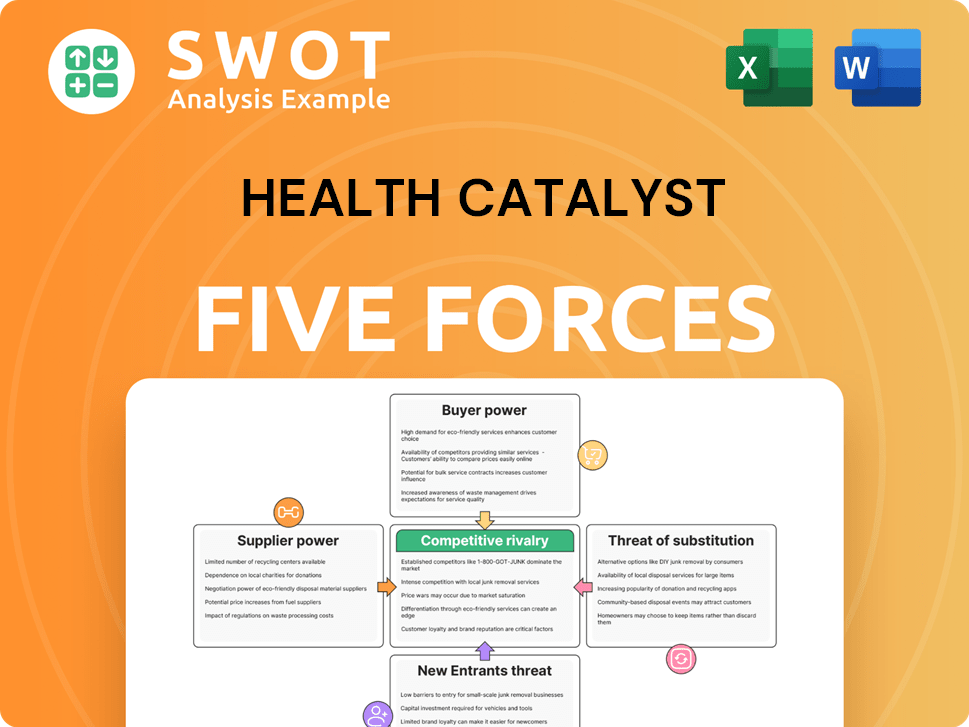
Related Blogs
- What are Mission Vision & Core Values of Health Catalyst Company?
- What is Growth Strategy and Future Prospects of Health Catalyst Company?
- How Does Health Catalyst Company Work?
- What is Sales and Marketing Strategy of Health Catalyst Company?
- What is Brief History of Health Catalyst Company?
- Who Owns Health Catalyst Company?
- What is Customer Demographics and Target Market of Health Catalyst Company?
Disclaimer
All information, articles, and product details provided on this website are for general informational and educational purposes only. We do not claim any ownership over, nor do we intend to infringe upon, any trademarks, copyrights, logos, brand names, or other intellectual property mentioned or depicted on this site. Such intellectual property remains the property of its respective owners, and any references here are made solely for identification or informational purposes, without implying any affiliation, endorsement, or partnership.
We make no representations or warranties, express or implied, regarding the accuracy, completeness, or suitability of any content or products presented. Nothing on this website should be construed as legal, tax, investment, financial, medical, or other professional advice. In addition, no part of this site—including articles or product references—constitutes a solicitation, recommendation, endorsement, advertisement, or offer to buy or sell any securities, franchises, or other financial instruments, particularly in jurisdictions where such activity would be unlawful.
All content is of a general nature and may not address the specific circumstances of any individual or entity. It is not a substitute for professional advice or services. Any actions you take based on the information provided here are strictly at your own risk. You accept full responsibility for any decisions or outcomes arising from your use of this website and agree to release us from any liability in connection with your use of, or reliance upon, the content or products found herein.